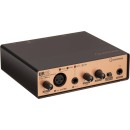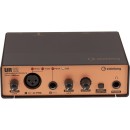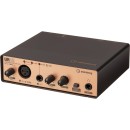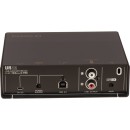Steinberg UR12 Audio Interface: An In-Depth Review
- High-quality 24-bit/192 kHz audio resolution.
- Class-A D-PRE mic preamp for pristine and clear sound.
- Compatible with major recording software thanks to its USB 2.0 connection.
- Rugged metal casing for durability.
- iPad connectivity for mobile recording options using the CC mode.
- Zero-latency hardware monitoring with mix knob.
- Balanced Line outputs for professional sound quality.
- Phantom power support for condenser microphones.
- Compact and portable design, ideal for home studios and mobile recording.
Specifications, Advantages, and Disadvantages of the Steinberg UR12
The Steinberg UR12 Audio Interface is a compact and versatile device designed for musicians, producers, and podcasters seeking high-quality audio recording capabilities. It features a sturdy metal chassis that ensures durability, making it ideal for both home studios and on-the-go recording sessions. The interface offers a sleek and user-friendly design, with easy access to all controls and inputs, which makes it suitable for both beginners and professionals.
Equipped with a high-performance D-PRE microphone preamp, the UR12 delivers pristine sound quality with low noise and distortion, allowing users to capture vocals and instruments with exceptional clarity. It features two input channels, including a balanced XLR input for microphones and a Hi-Z input for instruments such as guitars and basses. This makes the UR12 a versatile tool for various recording needs. Additionally, the interface supports up to 24-bit/192 kHz audio resolution, ensuring that recordings are of the highest fidelity.
The Steinberg UR12 is compatible with both Windows and Mac operating systems, and it seamlessly integrates with popular DAWs such as Cubase and other recording software. It also offers a convenient USB connection for power and data transfer, eliminating the need for an external power supply. With its rugged construction, high-quality preamps, and versatile connectivity, the Steinberg UR12 Audio Interface is an excellent choice for those looking to improve their recording capabilities without compromising on sound quality or functionality.
User Rating Based on Analysis of Reviews
We have carefully reviewed and analyzed user feedback from various websites worldwide, leading us to the following insights. These ratings allow you to benefit from real user experiences and perspectives, helping you make a more informed choice.
Overall Purchase Value
85% of users were satisfied with the overall purchase value of the Steinberg UR12, highlighting its affordability and the comprehensive features it offers for the price. Many users appreciated the cost-effectiveness, especially when compared to other interfaces with similar capabilities. The balance of price and performance made it a popular choice among both beginners and professionals looking for a reliable audio interface without breaking the bank.
Some users, comprising 15%, expressed dissatisfaction with the purchase value, citing that while the product is affordable, it sometimes lacks advanced features present in more expensive models. These users felt that the cost savings came at the expense of certain functionalities they deemed essential for professional audio production.
Quality of Materials
78% of users reported satisfaction with the quality of materials used in the Steinberg UR12, appreciating the sturdy and durable build of the device. This group highlighted the metal chassis as particularly robust, providing a sense of longevity and resilience against wear and tear, which is crucial for a product that's often transported and used in various environments.
However, 22% of users were dissatisfied, pointing out that while the outer casing was durable, some internal components felt flimsy or prone to issues after extended use. Complaints often revolved around the knobs and ports, which were sometimes perceived as less durable than the exterior suggested.
Ease of Setup
An impressive 92% of users were satisfied with the ease of setup of the Steinberg UR12, praising its plug-and-play compatibility with major operating systems and straightforward installation process. Many users commented on the clear instructions and intuitive design that facilitated a quick start, even for those new to audio interfaces.
A minority of 8% found the setup process challenging, primarily due to driver issues or compatibility problems with specific software. These users found the troubleshooting process frustrating, which detracted from their overall experience.
Sound Quality
88% of users were satisfied with the sound quality delivered by the Steinberg UR12, emphasizing the clarity and depth of audio it provided. Users praised the preamps for maintaining sound integrity, making it a favored choice for recording vocals and instruments with minimal distortion.
12% of users expressed dissatisfaction, mentioning that while the sound quality was generally good, there were instances of minor latency issues and noise interference, which could be problematic during professional recording sessions.
Portability
90% of users praised the portability of the Steinberg UR12, noting its compact size and lightweight design as ideal for mobile recording setups. The device's convenience in being easily transportable without compromising on functionality was a significant plus for musicians and producers on the go.
10% of users, however, found portability lacking, primarily due to the need for external power. These users felt that reliance on a power source limited the device's use in truly mobile settings, where battery-operated solutions might be preferable.
Customer Support
75% of users were content with the customer support provided by Steinberg, commending the responsiveness and helpfulness of the support team. Timely solutions and effective communication helped resolve most of their issues satisfactorily.
25% of users, however, found customer support lacking, citing delays in response times and occasionally unhelpful guidance. These users felt their problems were not always addressed adequately, leading to prolonged frustration.
Driver Compatibility
80% of users found the driver compatibility of the Steinberg UR12 satisfactory, reporting seamless integration with both Windows and Mac systems. This group appreciated the regular updates and stability offered by the drivers, which ensured smooth operation across various software.
20% of users, however, encountered compatibility issues, particularly with newer operating systems or specific DAWs. These users experienced difficulties in maintaining stable connections, which affected their workflow.
Latency
82% of users were satisfied with the low latency performance of the Steinberg UR12, which they found sufficient for real-time recording and monitoring. This made the device a reliable choice for both studio and live performances.
18% of users experienced higher latency than expected, which interfered with their recording process. This group found the latency issues particularly challenging when using resource-heavy plugins or larger session files.
Build Aesthetics
87% of users appreciated the build aesthetics of the Steinberg UR12, describing it as sleek and professional-looking. The design appealed to users who valued both functionality and visual appeal in their audio equipment.
13% of users were less impressed with the aesthetics, feeling that the design was too simplistic or not in line with their personal taste. This group preferred more visually striking or customizable options.
Microphone Preamp Quality
84% of users were pleased with the microphone preamp quality, noting the clear and noise-free amplification it provided. This made the Steinberg UR12 a preferred choice for vocalists and podcasters seeking high-quality recordings.
16% of users, however, found the preamp quality lacking, reporting occasional issues with noise and insufficient gain for certain microphones. This was a particular concern for users with higher-end mics requiring more robust preamp performance.
Headphone Output Quality
79% of users were satisfied with the headphone output quality, praising its ability to deliver clear and accurate sound, which is crucial for monitoring during recording sessions.
21% of users found the headphone output quality subpar, mentioning issues with volume levels and clarity that hindered effective monitoring. This was a significant drawback for users who rely heavily on headphone monitoring.
Instrument Input Quality
83% of users appreciated the instrument input quality of the Steinberg UR12, highlighting its effectiveness in capturing the nuances of guitars and other instruments without distortion.
17% of users were dissatisfied, pointing out occasional issues with input levels and clarity, which affected the accuracy of their recordings, particularly with dynamic and complex instrument sounds.
Durability
81% of users were satisfied with the durability of the Steinberg UR12, noting that the robust construction held up well under regular use and transportation.
19% of users, however, questioned the long-term durability, citing issues with component wear over time, such as loosening knobs and unreliable port connections.
Connectivity Options
76% of users were content with the connectivity options available, finding the USB and direct monitoring features adequate for their recording needs.
24% of users found the connectivity options limited, especially those requiring more advanced or diverse input/output configurations for complex setups.
Size and Weight
86% of users favored the size and weight of the Steinberg UR12, considering it ideal for space-conscious setups and easy transport.
14% of users, however, felt that the compact design compromised on certain features, such as additional input/output options, which affected their experience.
Software Bundle
77% of users were pleased with the software bundle included with the Steinberg UR12, which provided useful tools for recording and editing.
23% of users found the software bundle lacking, either due to limited features or compatibility issues with their preferred digital audio workstations.
Stability
82% of users found the Steinberg UR12 to be stable in its performance, with minimal crashes or technical issues during use.
18% of users experienced stability issues, often in the form of software glitches or connectivity problems that disrupted their workflow.
Warranty and Support
74% of users were satisfied with the warranty and support provided, noting the peace of mind it offered knowing that any defects would be covered.
26% of users felt the warranty and support were inadequate, citing difficulties in claiming warranty services and limited support for certain issues.
Versatility
79% of users appreciated the versatility of the Steinberg UR12, finding it suitable for a range of recording applications from podcasts to music production.
21% of users found the UR12 less versatile than expected, especially when compared to interfaces with more extensive feature sets or connectivity options.
User Interface
81% of users were satisfied with the user interface of the Steinberg UR12, praising its simplicity and ease of navigation, which helped streamline their recording process.
19% of users, however, found the user interface lacking in intuitiveness, particularly when accessing advanced settings or features, leading to some frustration during use.
In the following sections, we will delve into the specifications of the Steinberg UR12 Audio Interface, as well as discuss its advantages and disadvantages. This comprehensive review aims to provide you with a thorough understanding of this product, helping you make an informed purchasing decision.
Pros:
- High-quality audio recording with 24-bit/192 kHz resolution.
- Compact and portable design, making it easy to carry and set up.
- Compatible with both Windows and Mac operating systems.
- Robust build quality with a metal chassis.
- Offers phantom power for condenser microphones.
- Includes Cubase AI software for music production.
Cons:
- Limited to only two inputs, which may not be sufficient for larger recording setups.
- No MIDI input/output, limiting connectivity with MIDI devices.
- Lacks advanced features found in higher-end interfaces, such as multiple outputs or DSP effects.
- Direct Monitoring switch is inconveniently placed on the rear panel.
- No digital inputs or outputs, which limits future expandability.
General
| Channels of I/O | 2 Inputs / 2 Outputs |
|---|---|
| Built-In DSP | |
| Maximum Sampling Rate | 192 kHz / 24-Bit |
| Number of Microphone Inputs | 1 Preamp |
| Built-In Microphone | |
| Input Level Adjustment | 2x Knob |
| Expansion Slots |
Channels of I/O: The Steinberg UR12 Audio Interface features 2 inputs and 2 outputs, allowing users to connect various audio sources and send audio signals to different destinations. This configuration is suitable for small recording setups, providing the necessary flexibility for instruments, microphones, or other audio devices, making it ideal for home studios or mobile recording.Show More
Built-In DSP: The UR12 does not come equipped with built-in DSP (Digital Signal Processing). This means that users will not have access to onboard effects or processing capabilities directly within the interface. However, this can be beneficial for those who prefer to apply effects and processing in their digital audio workstation (DAW) software, allowing for greater control over the final sound during the mixing stage.
Maximum Sampling Rate: The audio interface supports a maximum sampling rate of 192 kHz at 24-bit depth. This high-quality specification ensures that recordings capture a wide frequency range and dynamic range, resulting in clearer and more detailed audio. A higher sampling rate is particularly advantageous for professional audio applications or when working with high-fidelity sound sources.
Number of Microphone Inputs: The UR12 includes 1 microphone preamp, making it suitable for solo recording projects that require high-quality vocal or instrument capture. A dedicated preamp enhances the audio signal from the microphone, ensuring clarity and fidelity in recordings. This feature is essential for achieving professional sound quality in various recording scenarios.
Built-In Microphone: The Steinberg UR12 does not feature a built-in microphone. This design choice allows users to connect their preferred external microphones, which can vary in type and quality. This flexibility is important for achieving specific sound characteristics and ensures that users can select mics that best suit their recording needs.
Input Level Adjustment: The interface provides a 2x knob for input level adjustment, allowing users to control the gain of the incoming audio signals easily. This feature is crucial for preventing distortion and ensuring that recordings are captured at optimal levels, thus maintaining audio integrity throughout the recording process.
Expansion Slots: The UR12 does not include any expansion slots. This means that the device is a standalone unit without the capability to add additional hardware or features. While this limits future upgrades, it also simplifies the design and usage, making it a straightforward option for users who need an efficient and easy-to-use audio interface without extra complexity.
Connectivity
| Analog Audio I/O | 1x XLR 3-Pin Balanced Mic Input 1x 1/4" TS Unbalanced Hi-Z Input 2x RCA TS Unbalanced Line Output 2x 1/4" TRS Unbalanced Headphone Output |
|---|---|
| Phantom Power | 48 V, Selectable On/Off |
| Digital Audio I/O | |
| Host Connection | 1x USB-B |
| Host Connection Protocol | Not Specified by Manufacturer |
| USB (Non-Host) | 1x Micro-USB (USB 2.0, Power Input) |
| Sync I/O | |
| Network I/O | |
| MIDI I/O |
The Analog Audio I/O specifications indicate the types and number of inputs and outputs available on the Steinberg UR12 Audio Interface. This model features a balanced XLR microphone input, which is ideal for connecting professional microphones, ensuring high-quality audio capture. Additionally, it includes a 1/4" TS unbalanced high-impedance input, suitable for instruments like guitars. The interface also provides two RCA TS unbalanced line outputs for connecting to monitors or other audio devices, as well as two 1/4" TRS unbalanced headphone outputs for monitoring audio directly. These varied inputs and outputs make the UR12 versatile for recording and playback needs.Show More
Phantom Power refers to the capability of the audio interface to provide 48 V power to condenser microphones that require it for operation. This feature is selectable, meaning users can turn it on or off depending on their needs. Having phantom power is crucial for ensuring that microphones that need external power can function properly, thus enhancing the overall recording quality.
Digital Audio I/O indicates that the UR12 does not support any digital audio inputs or outputs. This may limit connectivity with certain digital devices or systems; however, the focus on analog connections could be advantageous for users who prefer a more traditional setup.
Host Connection specifies the type of connection used to link the audio interface to a computer or other host devices. The UR12 features a USB-B connection, which is common for many audio interfaces, facilitating easy plug-and-play capabilities. The Host Connection Protocol is not specified by the manufacturer, which might imply compatibility with standard USB audio protocols but lacks detailed technical information.
The USB (Non-Host) connection on the UR12 is a Micro-USB port used primarily for power input, supporting USB 2.0. This allows the device to be powered via a compatible power source, which is particularly useful for mobile recording setups or when using devices without external power options.
Lastly, the absence of Sync I/O, Network I/O, and MIDI I/O indicates that the UR12 does not include features for synchronization with other audio devices, network connections for remote control or audio streaming, or MIDI connectivity for controlling instruments and software. This could limit its use in more complex setups but simplifies the design for users focused on basic recording and playback tasks.
Performance
| Dynamic Range | 101 dB |
|---|
The Dynamic Range specification refers to the difference between the loudest and quietest sounds that an audio interface can effectively reproduce. In the case of the Steinberg UR12, a dynamic range of 101 dB indicates that it can handle a wide range of audio signals without distortion or loss of quality. This is particularly important for capturing nuanced sounds and ensuring clarity in recordings.Show More
A higher dynamic range allows for more detail in audio playback and recording, meaning that subtle elements in music or voice can be accurately captured and reproduced. For musicians and audio engineers, this specification is crucial when working with dynamic performances where the volume may vary significantly. A dynamic range of 101 dB provides a professional level of performance suitable for various applications, from home studios to more advanced recording environments.
Digital Audio
| Sample Rates | 192 kHz |
|---|---|
| Bit Depths | 24-Bit |
Sample Rates refer to the number of times per second an audio signal is sampled during the conversion process from analog to digital. In the case of the Steinberg UR12, it supports a maximum sample rate of 192 kHz. Higher sample rates allow for greater detail and clarity in audio, capturing more nuances of sound. This makes it particularly beneficial for professionals working with high-fidelity audio recordings, as it can reproduce frequencies beyond the human hearing range, leading to a more accurate representation of the original sound.Show More
Bit Depths determine the amount of information captured in each audio sample. The UR12 features a bit depth of 24-Bit, which provides a dynamic range of 144 dB. This allows for both very quiet and very loud sounds to be recorded without distortion. A higher bit depth means more precise audio representation, resulting in improved clarity and detail in recordings. This is essential for ensuring that subtle changes in dynamics and tonal quality are preserved, making it ideal for professional audio production and mixing.
Audio Storage & Playback
| Memory Card Slot |
|---|
The Steinberg UR12 Audio Interface does not include a memory card slot. This feature is typically found in devices that allow users to store audio files or project data directly on the device. The absence of a memory card slot means that users will need to rely on external storage solutions such as a computer or external hard drives for saving their audio recordings and projects. This can be a limitation for those who prefer portable solutions for recording and playback.Show More
While the lack of a memory card slot may seem like a drawback, it is important to note that many audio interfaces, including the UR12, are designed to work seamlessly with digital audio workstations (DAWs) and other software on a computer. This means that users can still achieve high-quality recordings and playback without the need for onboard storage. The focus of the UR12 is on providing excellent audio quality and low latency, which is often prioritized over built-in storage capabilities.
Compatibility
| OS Compatibility | macOS 10 or Later 10 or Later Windows 7 or Later |
|---|---|
| Included Software | |
| RAM Requirements | 4 GB |
| Mobile Device Compatibility | iPad iPhone |
| Internet Connection | Required for Registration, Software/Driver Download |
OS Compatibility refers to the operating systems that the Steinberg UR12 audio interface is designed to work with. It supports macOS versions 10 and later, as well as Windows 7 and later. This broad compatibility ensures that users can integrate the device into a variety of setups, whether they are using a Mac or a PC, allowing for flexibility in choosing their preferred operating system.Show More
Included Software indicates whether any additional software comes bundled with the audio interface. In this case, there is no included software, meaning that users will need to procure any necessary software separately to utilize the full capabilities of the UR12. This could impact the overall user experience, as users might need to invest additional time and resources in finding compatible software solutions.
RAM Requirements specify the amount of random access memory needed to effectively run the audio interface alongside other applications. The UR12 requires at least 4 GB of RAM, which is a standard figure that ensures smooth operation and efficient performance during audio processing tasks. Having sufficient RAM helps in avoiding latency issues and allows for better multitasking capabilities.
Mobile Device Compatibility highlights the ability of the UR12 to connect and function with mobile devices, specifically iPads and iPhones. This feature enhances the versatility of the audio interface, providing musicians and audio professionals with the option to record or process audio on-the-go, thus expanding their creative possibilities.
Internet Connection is necessary for registration and downloading software or drivers for the UR12. This requirement underscores the importance of having internet access to ensure that users can set up their devices properly and access any updates or technical support. Without an internet connection, users may face difficulties in fully utilizing the features of the audio interface.
Power
| Power Requirements | DC Input, USB Bus Power |
|---|---|
| AC/DC Power Adapter | 4.8 to 5.2 VDC (Not Included) |
| Current Consumption | 0.5 A |
Power Requirements: This section outlines the various power options for the Steinberg UR12 Audio Interface. It highlights that the device can be powered through a DC input, USB bus power, or an AC/DC power adapter. The flexibility in power sources allows users to operate the interface in different environments, whether connected to a computer or used in a more mobile setting.Show More
DC Input: The UR12 requires a voltage range of 4.8 to 5.2 VDC for proper operation. This specification ensures that the device operates efficiently without overheating or malfunctioning. Users must provide a compatible power supply, as it is not included with the interface.
Current Consumption: With a current consumption of 0.5 A, the UR12 is designed to be energy-efficient while delivering high performance. This low current draw makes it suitable for use with portable devices and reduces the load on the power source, which is particularly beneficial for battery-operated setups.
Physical
| Rackmount Size | 1 RU (1/3-Rack) |
|---|---|
| Dimensions | 6.3 x 5.7 x 1.9" / 15.9 x 14.4 x 4.7 cm |
| Weight | 1.9 lb / 850.0 g |
Rackmount Size refers to the physical size of the audio interface in relation to standard rack systems. A 1 RU (1/3-Rack) size indicates that the UR12 is compact and can fit into a standard 19-inch rack mount setup, taking up a single rack unit of space. This design is particularly advantageous for users with limited space or those who need to transport their equipment frequently, as it allows for easy integration into both studio and live environments.Show More
Dimensions provide the exact measurements of the device, which are 6.3 x 5.7 x 1.9 inches (15.9 x 14.4 x 4.7 cm). These dimensions highlight the compact nature of the UR12, making it a portable option for musicians and producers who may need to carry their gear to different locations. The small footprint ensures that it can fit snugly into various setups without taking up excessive desk or rack space.
Weight is another critical specification, with the UR12 weighing 1.9 lb (850.0 g). This lightweight design enhances its portability, making it easy to carry around for gigs or studio sessions. A lighter audio interface is beneficial for those who may need to set up and dismantle their equipment frequently, as it reduces the physical strain associated with transporting gear.
Packaging Info
| Package Weight | 2.935 lb |
|---|---|
| Box Dimensions (LxWxH) | 9.2 x 8 x 4.1" |
Package Weight: The package weight of 2.935 lb indicates the total weight of the UR12 Audio Interface when it is boxed and ready for shipping. This weight is significant for users who may need to consider shipping costs or portability. A lighter weight can make the device easier to transport, which is beneficial for musicians and audio engineers who perform or work in various locations.Show More
Box Dimensions (LxWxH): The dimensions of the box, measuring 9.2 x 8 x 4.1 inches, provide a sense of the overall size of the packaging. This information is useful for users who want to ensure that they have adequate space for storage or transportation. Additionally, compact dimensions can indicate a more portable product, making it easier to fit into a backpack or equipment case for travel.
Customer Questions
How do I connect the Steinberg UR12 to my computer?
To connect the Steinberg UR12 to your computer, use the included USB cable. Plug one end into the UR12 and the other into a USB port on your computer. Make sure the UR12 is powered on before you start using it.
Why is there no sound coming from my UR12?
Ensure that the UR12 is selected as the audio input and output device in your computer's sound settings. Also, check the connections to your speakers or headphones and make sure the input gain and output volume knobs on the UR12 are turned up.
How do I install the drivers for the UR12?
Visit the Steinberg website and download the latest drivers for the UR12. Run the installer and follow the on-screen instructions to complete the installation. After installation, restart your computer to ensure the drivers are properly loaded.
What software is compatible with the UR12?
The UR12 is compatible with most DAWs including Cubase, Ableton Live, FL Studio, Logic Pro X, and more. Make sure to configure the UR12 as your audio interface within the software settings.
Why is there a delay in the audio playback?
This issue is usually related to latency settings. Adjust the buffer size in your DAW or audio settings to a lower value to reduce latency. Ensure that the UR12 drivers are correctly installed and up-to-date.
How do I update the firmware on my UR12?
To update the firmware, check the Steinberg website for the latest firmware version. Download the update file and follow the instructions provided to update your UR12.
Why is my microphone not working with the UR12?
Ensure that your microphone is connected to the Mic/Line input and the +48V phantom power switch is on if your microphone requires it. Check that the input gain is set appropriately and the UR12 is selected as the input device in your audio settings.
Can I use the UR12 with an iPad?
Yes, you can use the UR12 with an iPad. You will need a Lightning to USB Camera Adapter to connect the UR12 to the iPad. Ensure that the UR12 is powered via the USB power cable provided.
What is the function of the direct monitor switch on the UR12?
The direct monitor switch allows you to hear your input signal directly without any latency. When enabled, you'll hear the input signal directly through your headphones or speakers connected to the UR12.
How do I set up the UR12 for recording in Cubase?
In Cubase, go to 'Device Setup' and choose 'VST Audio System.' Select 'Yamaha Steinberg USB ASIO' as your ASIO driver. Then, set up your input and output buses in 'VST Connections' to use the UR12 for recording and playback.




